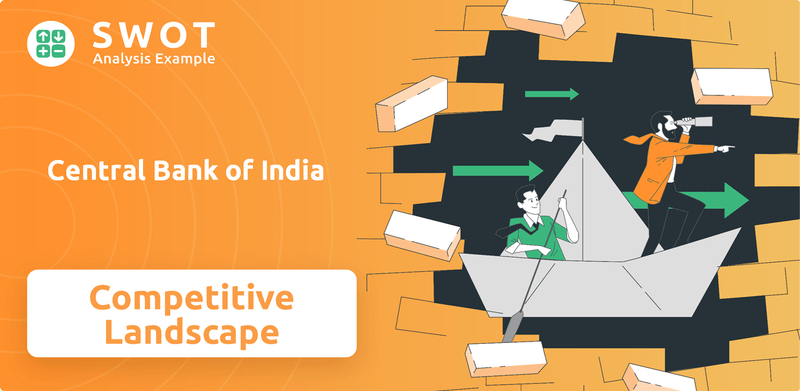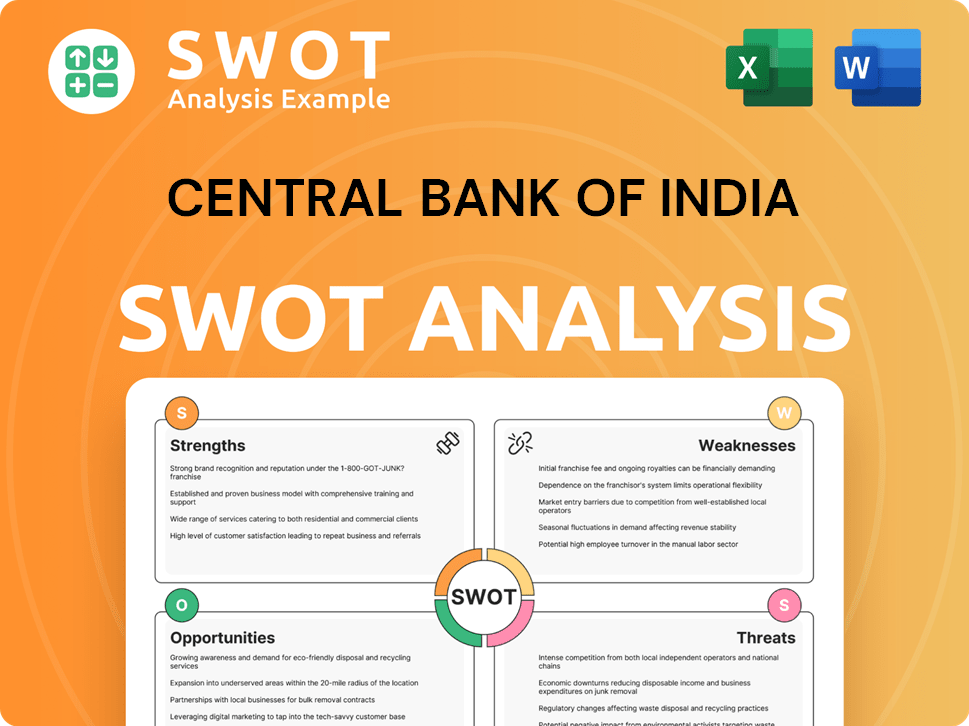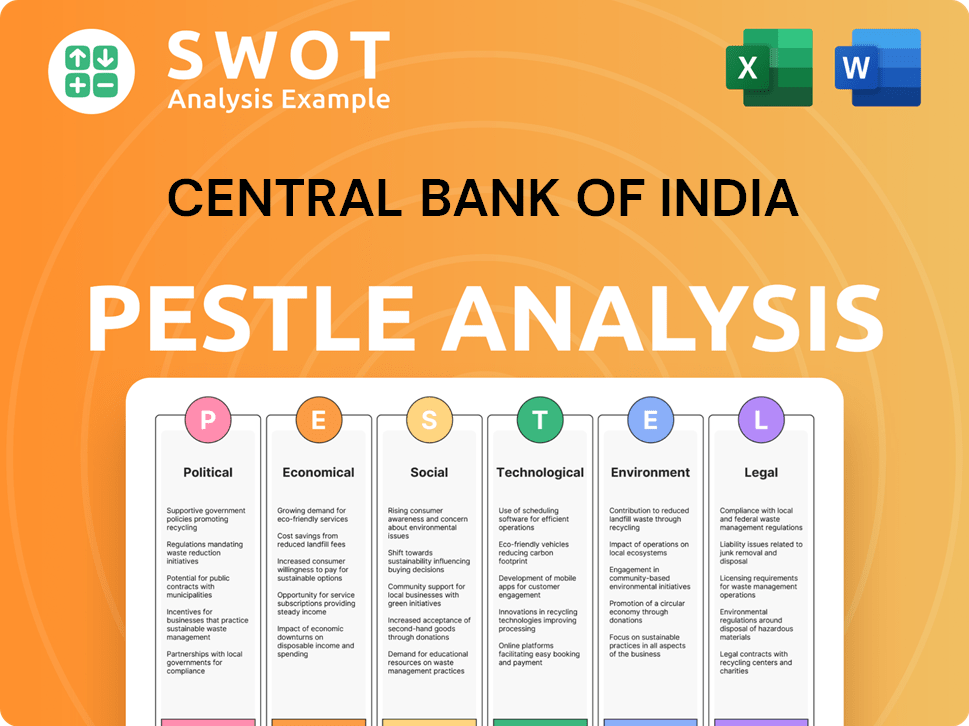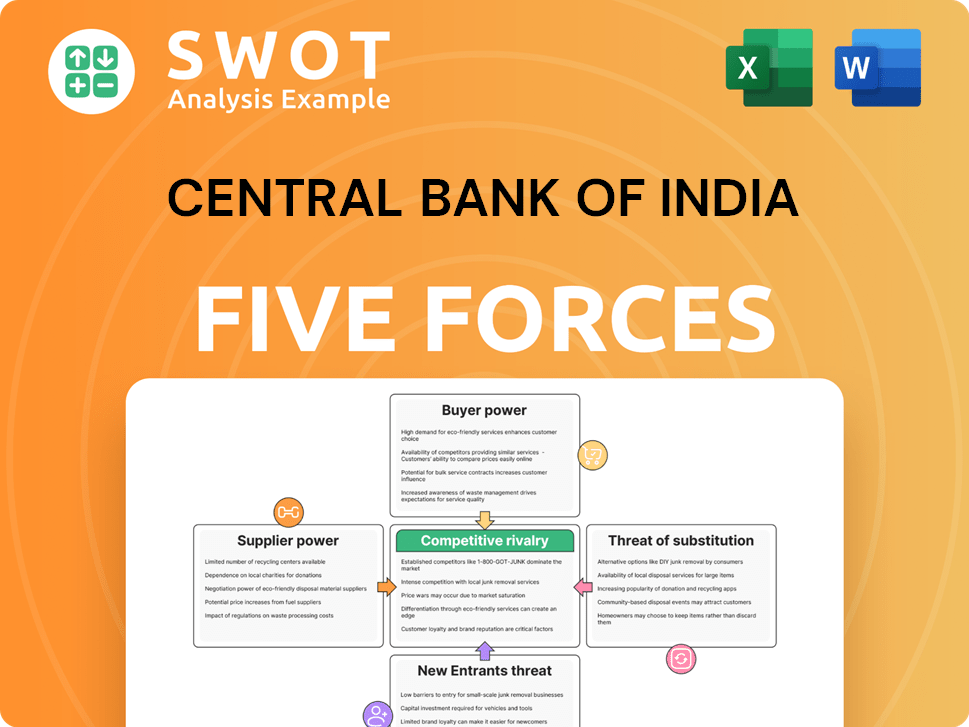Central Bank of India Bundle
How Does Central Bank of India Navigate the Cutthroat Banking Sector?
The Indian banking industry is a battlefield of innovation and competition, constantly reshaped by digital advancements and evolving customer demands. Central Bank of India, a historical titan, continues to compete in this dynamic arena. Understanding the Central Bank of India SWOT Analysis is crucial to grasp its position.

This CBI analysis explores the intricate competitive landscape, examining key players and market dynamics. We'll dissect Central Bank of India's strategies, evaluating its market share and how it stacks up against rivals in the Indian banking industry. This report offers insights into the competitive strategies of Central Bank of India, crucial for investors and strategists alike.
Where Does Central Bank of India’ Stand in the Current Market?
The Central Bank of India (CBI) holds a significant position within the Indian banking sector. Its operations are centered around providing a comprehensive range of financial services to a diverse customer base. These services include retail banking, corporate banking, and lending to Micro, Small, and Medium Enterprises (MSMEs).
CBI's value proposition lies in its extensive network and focus on customer service, particularly in semi-urban and rural areas. The bank aims to provide accessible and reliable banking solutions, supported by a growing emphasis on digital transformation to improve efficiency and customer experience. This approach allows CBI to cater to a wide array of financial needs, from deposits and loans to investment products and financial transactions.
As of March 2024, CBI reported a total business of ₹6,00,000 crore, demonstrating its substantial scale within the Indian banking industry. Its widespread presence, with over 4,500 branches and 3,500 ATMs, strengthens its ability to serve a broad customer base across India. This extensive network is a key factor in its market position, particularly in regions where access to banking services may be limited.
CBI has shown improving financial health, with net profit increasing to ₹2,530 crore in FY24 from ₹1,570 crore in FY23. The bank's focus on asset quality is evident in the reduction of net non-performing assets (NPAs) to 1.23% as of March 2024. The Revenue Streams & Business Model of Central Bank of India further explains its financial strategies.
CBI's competitive landscape includes both public and private sector banks in India. Its market position is influenced by factors such as its branch network, digital banking capabilities, and financial performance. The bank's ability to maintain and improve asset quality, along with its focus on customer service, are critical to its competitive strategy.
- Geographic Reach: Extensive branch network across India.
- Customer Segment Focus: Serving retail, MSME, and corporate clients.
- Financial Health: Improved profitability and asset quality.
- Digital Transformation: Enhancing customer experience and operational efficiency.
Central Bank of India SWOT Analysis
- Complete SWOT Breakdown
- Fully Customizable
- Editable in Excel & Word
- Professional Formatting
- Investor-Ready Format

Who Are the Main Competitors Challenging Central Bank of India?
The competitive landscape for the Central Bank of India (CBI) is dynamic, with the bank facing challenges from both public and private sector banks. A thorough CBI analysis reveals a need to constantly adapt to maintain its market position within the Indian banking industry. Understanding the competitive strategies of Central Bank of India is crucial for stakeholders.
The banking sector competition in India is intense, driven by technological advancements and evolving customer expectations. CBI's ability to compete effectively depends on its capacity to innovate and provide superior customer service. This necessitates a focus on digital banking competition and the development of competitive advantages.
The competitive landscape of Central Bank of India includes a variety of players, each with their own strengths and strategies. To understand the bank's position, it's important to examine its key competitors and how they impact CBI's market share.
CBI competes directly with other public sector banks. These banks often have extensive branch networks and benefit from government support. State Bank of India (SBI) is a major competitor due to its size and reach.
Private sector banks like HDFC Bank, ICICI Bank, and Axis Bank are significant competitors. These banks often lead in technological innovation and digital service offerings. They attract a tech-savvy customer base.
Fintech companies introduce indirect competition by offering specialized services. These companies focus on areas like digital lending and payment solutions. They push traditional banks to innovate.
CBI's branch network, though extensive, is a key factor in its competitive strategy. Its reach across various regions allows it to serve a diverse customer base. This is a crucial aspect when comparing CBI to other banks.
The shift towards digital banking is a major competitive factor. CBI must invest in digital platforms and services to stay competitive. HDFC Bank's success in this area highlights the importance of digital transformation.
Customer service quality is a key differentiator. Banks with superior customer service often gain a competitive edge. CBI needs to focus on improving customer satisfaction to retain and attract customers.
In the competitive landscape, CBI must continually assess its strengths and weaknesses. A SWOT analysis of Central Bank of India can help identify areas for improvement. For example, CBI's regional presence and competition vary across different areas, requiring localized strategies. Furthermore, the bank's financial performance comparison with its peers is essential for understanding its market position. The article Owners & Shareholders of Central Bank of India provides additional insights into the bank's structure and strategic direction.
The competitive landscape includes various players with different strategies. Understanding these strategies is crucial for CBI's success. The bank must adapt to stay competitive.
- State Bank of India (SBI): SBI leverages its extensive branch network and government backing. It focuses on offering a wide range of financial products and services. SBI's vast scale gives it a significant advantage in the market.
- HDFC Bank: HDFC Bank emphasizes digital banking and customer service. Its innovative approach attracts a tech-savvy customer base. HDFC Bank's focus on technology is a key differentiator.
- ICICI Bank: ICICI Bank invests heavily in technology and marketing. It aims to capture a significant market share through aggressive strategies. ICICI Bank's digital initiatives are a major focus.
- Punjab National Bank (PNB): PNB competes through its branch network and government schemes. It targets a broad customer base with traditional banking services. PNB's focus remains on core banking operations.
Central Bank of India PESTLE Analysis
- Covers All 6 PESTLE Categories
- No Research Needed – Save Hours of Work
- Built by Experts, Trusted by Consultants
- Instant Download, Ready to Use
- 100% Editable, Fully Customizable

What Gives Central Bank of India a Competitive Edge Over Its Rivals?
The competitive landscape of the Central Bank of India (CBI) is shaped by its unique strengths and the broader dynamics of the Indian banking industry. A thorough CBI analysis reveals that the bank's strategies and market position are influenced by both its historical significance and its ongoing efforts to adapt to a rapidly changing financial environment. Understanding these factors is crucial for assessing CBI's ability to maintain and enhance its competitive edge.
The Indian banking industry is highly competitive, with both public and private sector banks vying for market share. CBI's performance is directly impacted by its ability to navigate this environment, leveraging its core competencies while addressing challenges such as technological advancements and evolving customer expectations. The bank's strategic initiatives, including digital transformation and asset quality improvement, are critical in maintaining its relevance and competitiveness.
CBI's ability to compete is also influenced by macroeconomic factors, regulatory changes, and the overall health of the Indian economy. Its financial performance, including profitability and asset quality, reflects its effectiveness in managing these external influences and executing its strategic plans. CBI's competitive advantages are essential for its long-term success in the Indian banking sector.
CBI's widespread branch network, particularly in semi-urban and rural areas, is a significant competitive advantage. This extensive physical presence fosters strong customer relationships and trust. As of March 31, 2024, CBI had a network of 4,462 branches across India, ensuring a broad reach.
Being a public sector bank, CBI benefits from a perception of reliability and security, which is attractive to a large segment of the Indian population. This legacy, combined with its long history, builds customer trust. The bank's government backing provides a degree of stability and confidence.
CBI has a large existing customer base and a strong legacy of public service. Its involvement in government-sponsored financial inclusion schemes helps it reach underserved populations, fostering goodwill and customer loyalty. CBI's focus on social welfare programs strengthens its market position.
CBI is actively pursuing digital transformation to enhance customer convenience and remain competitive. This includes the launch of new mobile banking applications and online services. CBI's digital initiatives are designed to improve customer experience and streamline banking processes.
CBI's competitive advantages are multifaceted, encompassing its extensive branch network, government backing, and focus on customer service. These strengths enable it to compete effectively in the diverse Indian banking market. The bank's strategic initiatives, including digital transformation and asset quality improvement, are crucial for future growth.
- Extensive Reach: CBI's widespread branch network ensures a strong presence across India, particularly in semi-urban and rural areas.
- Customer Trust: The bank's long-standing history and government ownership contribute to a perception of reliability and security.
- Financial Inclusion: CBI's participation in government-sponsored schemes allows it to reach underserved populations.
- Digital Initiatives: The bank's efforts in digital transformation enhance customer convenience and streamline banking processes. For more information, see Marketing Strategy of Central Bank of India.
Central Bank of India Business Model Canvas
- Complete 9-Block Business Model Canvas
- Effortlessly Communicate Your Business Strategy
- Investor-Ready BMC Format
- 100% Editable and Customizable
- Clear and Structured Layout

What Industry Trends Are Reshaping Central Bank of India’s Competitive Landscape?
The Indian banking industry is experiencing significant shifts, with the Central Bank of India (CBI) navigating a dynamic competitive landscape. Key trends include rapid digitalization, evolving regulatory frameworks, and changing consumer expectations. These factors influence CBI's strategic positioning and require continuous adaptation to maintain and enhance its market share.
CBI faces challenges such as intensifying competition from private banks and fintech companies, along with the need to manage asset quality effectively. However, the bank also has opportunities, particularly in expanding its digital services and leveraging its strong presence in semi-urban and rural markets. This article provides a CBI analysis, examining the competitive landscape and future prospects.
The Indian banking industry is seeing a surge in digital banking, with mobile banking and online payments becoming increasingly popular. Regulatory changes, like those focused on governance and asset quality, are also reshaping operations. Consumer preferences are shifting towards personalized and seamless digital experiences, pushing banks to innovate.
CBI faces growing competition from technologically advanced private banks and fintech startups. Managing asset quality, especially during economic fluctuations, remains a key concern. Adapting to evolving customer expectations and the need for continuous technological upgrades also presents challenges.
CBI can leverage its strong presence in semi-urban and rural markets for financial inclusion and micro-lending. Increasing digital literacy in India offers opportunities to expand digital services. Strategic partnerships with fintech companies can facilitate technology adoption and service expansion.
CBI is focusing on digital transformation and retail growth to adapt to industry trends. Efforts to improve financial health, coupled with a customer-centric approach, are key. The bank's ability to manage risks and adapt to technological advancements will be crucial for its success.
CBI's strategic focus areas include digital banking, customer experience, and financial inclusion. The bank is investing in technology and partnerships to enhance its digital offerings and reach a wider customer base. A strong emphasis on risk management and regulatory compliance is also essential.
- Digital Banking: Expanding mobile and online banking services.
- Customer Experience: Improving service delivery and customer satisfaction.
- Financial Inclusion: Targeting semi-urban and rural markets.
- Risk Management: Strengthening asset quality and regulatory compliance.
Central Bank of India Porter's Five Forces Analysis
- Covers All 5 Competitive Forces in Detail
- Structured for Consultants, Students, and Founders
- 100% Editable in Microsoft Word & Excel
- Instant Digital Download – Use Immediately
- Compatible with Mac & PC – Fully Unlocked

Related Blogs
- What are Mission Vision & Core Values of Central Bank of India Company?
- What is Growth Strategy and Future Prospects of Central Bank of India Company?
- How Does Central Bank of India Company Work?
- What is Sales and Marketing Strategy of Central Bank of India Company?
- What is Brief History of Central Bank of India Company?
- Who Owns Central Bank of India Company?
- What is Customer Demographics and Target Market of Central Bank of India Company?
Disclaimer
All information, articles, and product details provided on this website are for general informational and educational purposes only. We do not claim any ownership over, nor do we intend to infringe upon, any trademarks, copyrights, logos, brand names, or other intellectual property mentioned or depicted on this site. Such intellectual property remains the property of its respective owners, and any references here are made solely for identification or informational purposes, without implying any affiliation, endorsement, or partnership.
We make no representations or warranties, express or implied, regarding the accuracy, completeness, or suitability of any content or products presented. Nothing on this website should be construed as legal, tax, investment, financial, medical, or other professional advice. In addition, no part of this site—including articles or product references—constitutes a solicitation, recommendation, endorsement, advertisement, or offer to buy or sell any securities, franchises, or other financial instruments, particularly in jurisdictions where such activity would be unlawful.
All content is of a general nature and may not address the specific circumstances of any individual or entity. It is not a substitute for professional advice or services. Any actions you take based on the information provided here are strictly at your own risk. You accept full responsibility for any decisions or outcomes arising from your use of this website and agree to release us from any liability in connection with your use of, or reliance upon, the content or products found herein.